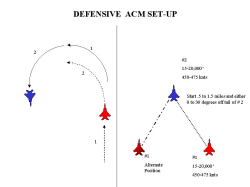| ACM Training: Janes Combat.net by Warren "Big Red" Hudson |
||||
|
Back to ACM Page 1 of 5 You can spend as much or as little time as you like doing this. In addition, you can "ring" the jet out and get a feel for the systems, calibrate your MK 1 eyeballs to what other jets look like on Combat.Net, etc. Take time to check out the various TACAN channels and waypoints which are loaded and see where they lead. This in itself is a full mission and one which normally would be ended by a RTB (return to base) for pattern work and a full stop. You can do this as practice now or you can set up for a fight. If you land, your fuel isn't replaced or aircraft re-armed. Let's set up for some air combat maneuvers (ACM).
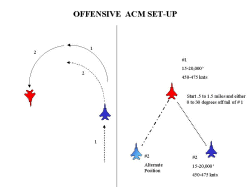
TRNMSN 2: This is the reverse of scenario one. # 2 is now the defensive fighter with # 1 the attacker. Set-up is the same with 1 and 2 switching initial positions and calls. Objective of # 2 is to 1) survive; 2) go neutral, and 3) gain the offensive and kill # 1 if able or else to separate. Again repeat as necessary until # 2 can consistently survive and gain the offensive.
TRNMSN 3: This is a neutral fight. You can start either by doing a basic intercept from 20-30 miles apart or you can start together. The neutral scenario is one where both pilots fight their best to gain the advantage, having started from a neutral position.
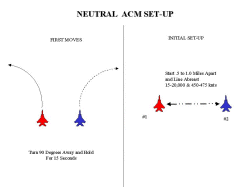 |
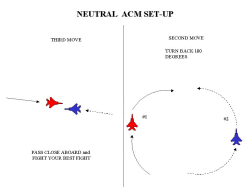 1. "How to Live and Die in the Virtual Sky" by Dan Crenshaw (Go to Training Index). 2. "Jane's Expert Flight Manual for F-15E" pgs. 4.72-4.84 3. "Fighter Combat" by Robert Shaw (I consider this the bible of fighter combat-a must read) Ten Rules for Air to Air Combat
Training Syllabus Work Sheet 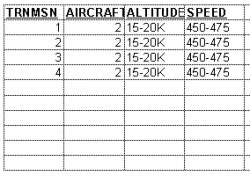 Click for full chart. Warren "Big Red" Hudson is a former USAF officer. During his 17 year career, he served as a fighter controller, instructor, evaluator, AWACS Mission Commander, and USAF Aggressor @ Nellis AFB. Warren has over 200 hours of backseat fighter time in USAF/Canadian T-33, F-4, CF-18, F-15, F-5/AT-38, and F-16. Additionally, he has over 1000 hours as an E-3 AWACS Mission Commander and over 6,000 recorded tactical engagements as a fighter controller.
|
|||
|
© 1997 - 2000 COMBATSIM.COM, INC. All Rights Reserved. Last Updated February 22nd, 1999 |
||||

